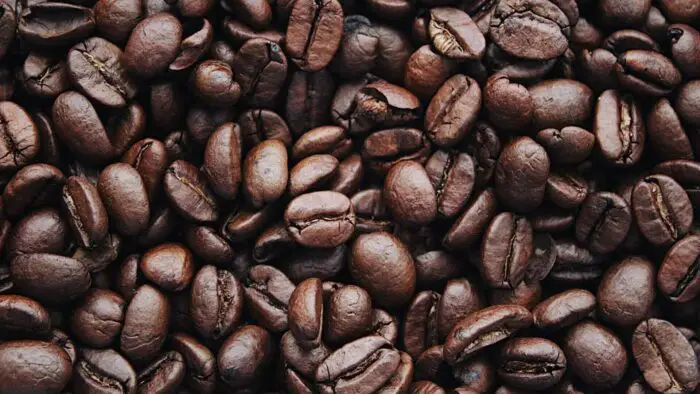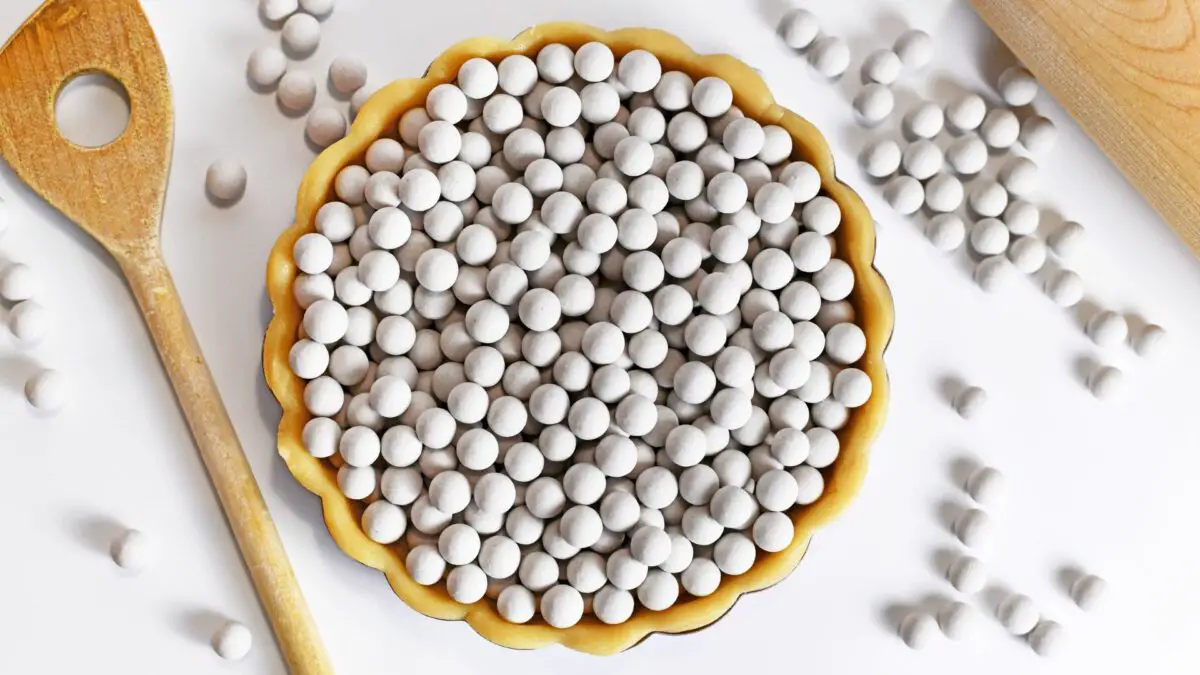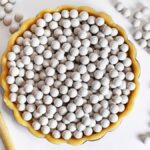Last Updated on February 23, 2023
Today, we look at some baking bean substitutes. These are all easy to find, easy to use, and don’t require any special steps!
What Are Baking Beans?
Before looking at baking bean substitutes, it’s important to understand what baking beans are and how they work. They are also called pie weights and are small metal or ceramic-weighted balls.
Their function is to weigh down pastries that are going to be pre-baked or partially baked. Why is this a necessary step?
Well, pre-baking or par-baking is a technique used to prevent the pie filling from making the pastry soggy. It also helps the dough bake evenly and effectively before any fillings are added. And finally, it helps prevent the pastry from bursting apart as it tries to rise.
To blind bake a pastry, first you place a sheet of non-stick baking paper over the entire pastry. It should extend over all of the sides. Then, the pie weights are placed into the baking paper shell. After it has been baked, the baking beans are removed and allowed to cool down to room temperature.
Unfortunately, buying baking beans can be expensive. Not to mention, they are sometimes very hard to find. For this reason, we’ve compiled a list of the best baking bean substitutes you can use.
The Best Baking Beans Substitutes
Below are our favorite baking beans substitutes that are very easy to use. You likely already have some at home!
1. Grains
The most popular option is uncooked (raw) rice. But, you can also use millet, popcorn kernels, sorghum, spelt, oats, barley, and rye. All of these are available whole.
And, because they are completely dried, they won’t “cook” inside the oven as the pastry par-bakes. Grains are an easy option that you likely already have at home. And, it is reusable and cheap.
Just do not eat them after you have used them as baking bean substitutes.
2. Pulses
Next, similar to grains, dried pulses will work great too. This includes lentils, soybeans, red beans, chickpeas, peas, and kidney beans. All of these should also be completely dry.
You can use them in exactly the same way. They are a little bit more expensive than most grains, but still not as expensive as baking beans. And again, they are reusable and easy to find.
3. Sugar
Next up, we have an incredibly easy alternative. You can use any type of granulated sugar you have available in your pantry. And don’t worry, they won’t melt inside the oven.
The sugar will however toast a bit. This doesn’t make it inedible, but you won’t want to use it in just any recipe.
4. Flour
You can use any type of flour that you’d like. The only time you shouldn’t use flour as a pie weight is if you are baking in a convection oven (which uses fans). The fans will blow the flour all over the oven, creating a big mess.
If you are baking without fans, the cheapest flour is the best. The flour will toast and maybe even burn a little. So, you can reuse it as baking weights, but not in recipes themselves.
5. Coins
If you have a couple of coins laying around the house, they will make excellent baking bean substitutes. And, they are completely reusable as coins and as pie weights.
Place them on top of your parchment paper in a single layer. If you think that they aren’t heavy enough, stack another layer on top of them.
6. Coarse salt
Not everybody has a bunch of coarse salt on hand. However, if you do, it’s an excellent reusable pie-weight option. It can be used in food again as well as for curing and salting food.
Coarse salt is also very heavy, so you don’t need to use it a lot for it to be effective. And, it is very affordable.
If you only have fine salt, you should use it in conventional ovens only (ovens without fan settings). You will also need a lot of fine salt before it will effectively weigh down the pastry.
7. Coffee beans
And finally, coffee beans will also make a great baking bean alternative. but, you’ll need a lot. Coffee beans aren’t very heavy in a single layer. Make sure that your paper won’t lift up and that the pastry will be weighed down.
You can also not reuse coffee beans after they have been baked. The flavor will be far too bitter to be enjoyable as coffee. But, you can still use them as deodorizers or baking weights.

In Conclusion
We hope that you find baking bean substitutes that work for you on our list. But, if you still need some ideas, let us know in the comments below.
And, if you know of anyone else wanting to learn some tricks in the kitchen, feel free to share this article!
Read more about How Long To Let Pie Cool
FAQs
What can I use if I don't have pie weights or beans?
There are a ton of alternatives for traditional pie weights and beans. You can use raw and uncooked pulses and grains. Or, you can use granulated sugar, flour, coarse salt, or ovenproof marbles.
Are baking beans necessary?
If your recipe says that you have to bake dough or pastry with baking beans, it is necessary. Baking beans helps ensure that the pastry doesn't rise too much and breaks apart. It also helps the pastry bake evenly and uniformly. So, don't skip this step. Rather substitute the baking beans with an alternative on our list.
How do you blind bake pastry without baking beans?
If you need to blind-bake pastry, you have to weigh it down with something. Otherwise, it defeats the purpose of the process. Blind baking ensures the pastry bakes evenly and doesn't form excessive air pockets. So, use uncooked grains and pulses. You can even use granulated sugar or flour if you have to!
How do I substitute rice for baking beans?
It is an effortless process. All that you do is used uncooked dry rice instead of baking beans. Place your layer of non-stick baking paper on the dough. Make sure that the entire surface is covered in at least 1/4 of an inch of rice. This ensures all the areas will heat and bake evenly and that the paper will be kept down on the edges too.
How to Blind Bake a Pie Crust
Equipment
- Aluminium Foil
- Pie Weights
Ingredients
- Frozen Pie Crust
Instructions
- Once you have your equipment and ingredients gathered, first you'll need to preheat your oven to 350F.
- Remove your pie crust from the freezer and use your foil to line your pie crust. Ensure the foil is covering the edges of the pie crust. Use more than one layer if necessary.
- Add your pie weights into the center of your pie crust. You can use any of the ideas above and they'll all be adequate substitutes to use besides baking beans.
- Place your pie crust into the center of the oven and bake for around 50-60 minutes for best results. Once fully baked, remove the pie crust from the oven and use the edges of the foil to pull out your weights and use your pie crust as needed. Reuse your pie weights at a later use, depending what you've used.

Lindy Van Schalkwyk is a culinary specialist with a background in Advanced Cooking, Advanced Pâtisserie, Media Communications and Nutrition. She has gained invaluable experience in the culinary industry having worked in some of the top restaurants in Africa in 2016 and 2017. Her expertise in nutrition has enabled her to develop recipes for special dietary needs. In 2018, Lindy began working in the Food Media industry, focusing on recipe development, recipe writing, food writing and food styling.



